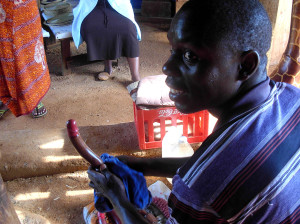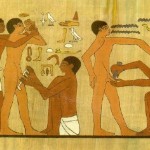With evidence that circumcision can reduce HIV risks [...]]]>
With evidence that circumcision can reduce HIV risks for men engaged in vaginal sex by up to 60%, the drive for voluntary medical male circumcision (VMMC) in adult men has taken on a new urgency. New ethical challenges are arising, beyond voluntarism and informed consent.

Circumcision is more than surgery – it is a personal, social and political marker. Our blogger unpacks meanings and impact of medical male circumcision campaigns in Africa.
How do we respect the principle of beneficence, ensuring procedures and programmes are good, not just for the person, but for society as a whole?
Non-malificence – the commitment to “first do no harm” – is crucial, and we should avoid unintentional consequences. The principle of justice should also be observed, with a focus on equity and fairness, especially when we allocate scarce resources.
Circumcision is more than just a biomedical procedure – it is a personal, social and political marker. It connotes difference or similarity. It can signify belonging to a particular religion, ethnicity, cultural group or power bloc in a country or region.
History is full of examples of circumcision being used as a tool of inclusion, exclusion and even marking for killing in times of conflict. Have we anticipated the impact of changes in identity that circumcision can signify?
Not just a cut
Not long ago I accompanied a young friend to a VMMC site in a hospital west of Pretoria, South Africa. I noticed that all the supporters of the young men in the ward (fathers, uncles, and friends) as well as the nursing staff, imbued the changed (circumcised) status of the young men with meanings around sexual prowess, transformation and rites of passage into proper masculine adulthood, away from maternal influences. For me, this suggests that VMMC is not a neutral intervention.
Current VMMC drives have failed to adequately engage with masculinity, tradition and traditional circumcision, possibly blurring intentions and outcomes.
Take the case of Swaziland, not traditionally a circumcising country. It had set ambitious targets for VMMC for HIV prevention but, by 2011, the country had only met about 12% of its target.
Against this backdrop, researcher Alfred Khehla Adams explored meanings of circumcision for Swazi men in the Kwaluseni district of Manzini.

Like the Zulus, Swazi people do not practice traditional male circumcision. Research shows that Swazi men fear medical circumcision will undermine their manhood, their constructed masculinity, beyond the foreskin. Credit: Mercedes Sayagues
Men feared reduced sexual pleasure and possible adverse effects, like wounds and swelling, and said the procedure threatened their notions of manhood.
Where manhood was defined as “someone who has a wife and children” and therefore is “sexually functional”, medical circumcision introduced a threat to this.
In South Africa, traditional circumcision (with its rituals, messages and meanings) is regarded as a non-negotiable rite of passage into acceptable masculinity for some groups, perhaps precisely because there is some risk. Mutilation, amputation and death do occur.
Here, VMMC has been met with some suspicion, a reluctance to accept a clinic circumcision as an acceptable test of manhood, among concerns that “culture” is being diluted.
Given that a clinic circumcision would maximise the HIV benefits of the cutting, because sufficient foreskin is removed, VMMC campaigns have to manage this tension between a desirable health outcome (medical circumcision) and an acceptable social identity (traditional circumcision).
Objectification of black bodies
Is VMMC a form of social engineering? Because some men refuse to use a condom, believing they have sufficient HIV protection from circumcision, some women have reported more difficult condom negotiations.
On a large scale, VMMC could thus impact on gender relations, especially in contexts where gender violence and rigid masculinities dominate.
Does mass circumcision of men represent a form of biomedical pessimism, seeing men as subjects, not citizens, incapable of agency and autonomy? This pessimism says men can’t change and won’t change, and therefore we need to intervene on their behalf.
And finally, does mass circumcision of African men represent a revitalisation of the “colonial project” that views black bodies and black sexualities in a particular way?
In South Africa, the apartheid state and parastatals such as the mines constructed medical machinery which viewed male bodies as objects to be medically managed and controlled, while at the same time the reproductive rights of black South Africans were limited through contraceptive programmes.
It would be naive, I believe, to ignore this history of objectification, and broader ethical debates, as donor money is used to save African men from themselves.
 Pierre Brouard, director of the Centre for the Study of AIDS at the University of Pretoria, South Africa, is a clinical psychologist interested in sexualities, gender, human rights, and finding just the right word to grace a sentence, convey empathy or complete a crossword.
Pierre Brouard, director of the Centre for the Study of AIDS at the University of Pretoria, South Africa, is a clinical psychologist interested in sexualities, gender, human rights, and finding just the right word to grace a sentence, convey empathy or complete a crossword.
So what headlines have grabbed you lately about male circumcision in South Africa? These caught my eye:
“The death toll in the Eastern Cape’s winter circumcision season has risen to 31”
“Circumcision ‘scam’ probed”
“Two [...]]]>

Hard task: defining sexual pleasure. Photo: M. Sayagues
So what headlines have grabbed you lately about male circumcision in South Africa? These caught my eye:
“The death toll in the Eastern Cape’s winter circumcision season has risen to 31”
“Circumcision ‘scam’ probed”
“Two on run after initiate dies”
As alarming and distressing as these headlines are – and the sad, desperate and greedy subtexts embedded in them – they don’t say much about the other big debate that is raging across southern Africa: the value of male circumcision to prevent HIV acquisition in heterosexual men, and what’s in it for women.
Well what’s in it for women is the topic du jour: Since observational studies had reported an association between male circumcision and reduced risk of HIV infection in female sexual partners, researchers in Uganda conducted an unblinded, randomised control trial to investigate this (Lancet July 2009) by circumcising some HIV positive men and not others. They found that circumcision did not reduce the risk of transmission to their female partners. So no luck there.
But what’s really getting gender activists of all genders to rise up from their sofas and comment on websites and chat rooms is the matter of sexual pleasure, and more specifically, the sexual pleasure of women.
What is sexual pleasure?
Now as a gay man I have to confess this is a topic that I have no personal experience of, but I am as interested in the notion of pleasure for my sisters of any sexual orientation as I am in mine.
I believe sexual pleasure should be a human right advanced to all, though for some of us this may be a progressive realisation of rights as we work through all the baggage of our socialisation!
I’m raising this issue because one of the many studies emerging as a companion to the now famous three circumcision trials, which showed the partial protective efficacy of male circumcision, suggests that “women whose male sexual partners were circumcised report an improvement in their sex life.”
Nearly 40% said sex was more satisfying afterward. About 57% reported no change in sexual satisfaction, and only 3% said sex was less satisfying after their partner was circumcised.

Ancient Egyptians get the snip.
Top reasons cited by women for their better sex life: improved hygiene, longer time for their partner to achieve orgasm, and their partner wanting more frequent sex, said Godfrey Kigozi at the Fifth International AIDS Society Conference on Pathogenesis, Treatment and Prevention of HIV in Cape Town recently.
Firstly, if you look at the data above, while 40% did say the sex was more satisfying, the majority in fact said there was either no change or it was less satisfying. Is the headline summary of the research accurate? Why do we need to spin this data?
Fluid and enigmatic
But really what’s vexed me, and others, is this notion of pleasure and how we define it. Those of us who come from a “social” as opposed to “biomedical” or “public health” paradigm would argue that sexuality is fluid, it changes over our lifetimes, it may be context or relationship dependent, it is informed not only by our gender but our class and orientation.
So “pleasure” in a sexual encounter may be shaped by mood, the time of life, the way a woman is relating to her partner that day, whether she was exhausted from chores, her beliefs about female agency in a sexual encounter, whether she was menstruating or in menopause, whether foreplay had occurred.
Pleasure, surely, is variable, contextual, dynamic, changing, unpredictable. Even enigmatic sometimes: a woman may have a good orgasm but still feel angry with her husband or partner. She may never have had an orgasm but feel happy that he does. She may secretly masturbate after he falls asleep and feel fantastic after that.
A biomedical or public health perspective, I would argue, reduces men and women and their practice to simple categories and distinct binaries: gay vs straight; masculine vs feminine; satisfied vs unsatisfied; safe vs dangerous.
This is necessary if you want a simplified view of the world and if you want “proof” that most women will be happy to have their male partners circumcised.
Who needs long and complicated qualitative research when a checklist with a choice of three options tells us all we need to know to placate those pesky social scientists with their doubts and ifs, buts and maybes? But how do you capture the nuances of satisfaction in a questionnaire?
You don’t. I think pleasure is much more complicated than that – and we need better and more interesting research to tease it out (as it were). What do you think?
Read more on controversial issues around male circumcision, sexual pleasure, human rights, viagra and condoms.
]]>